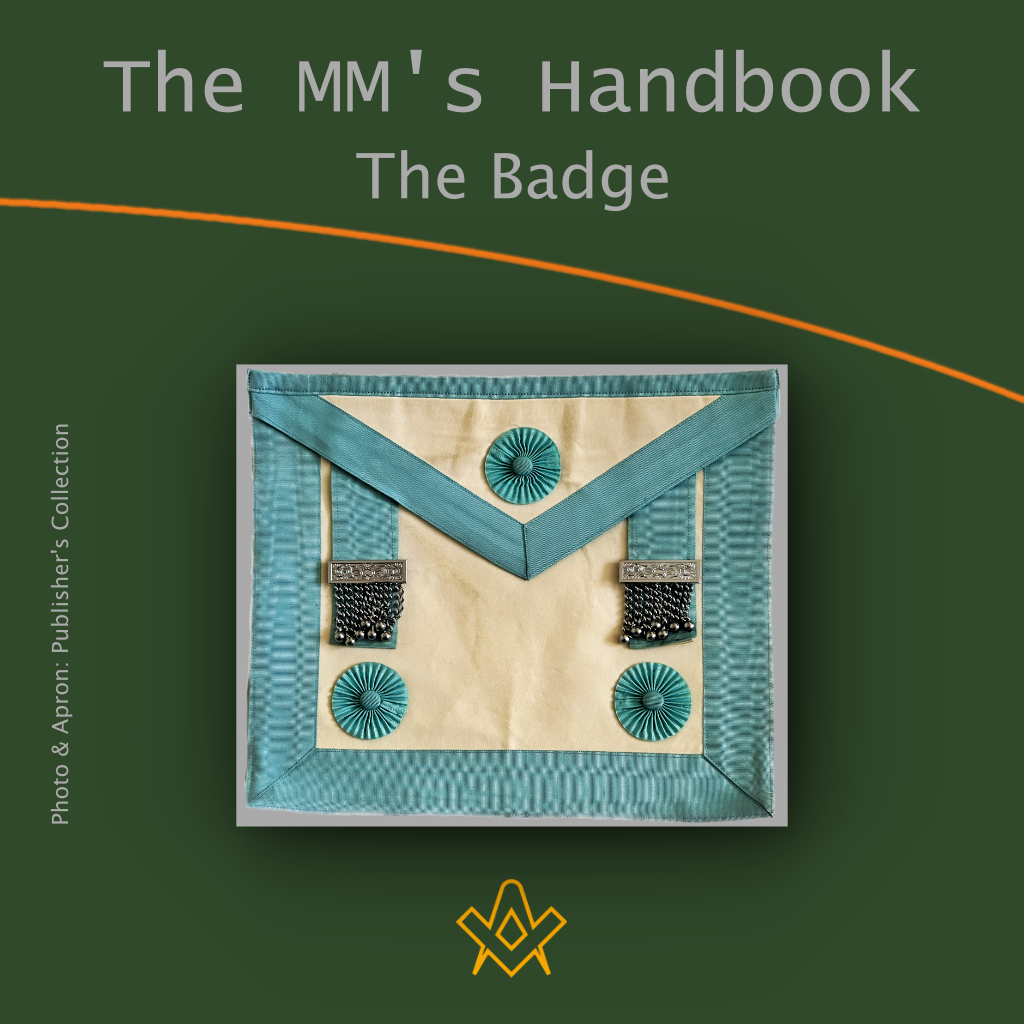On his re-entering the Lodge the candidate is presented, and in due course invested by the Senior Warden, as in the previous degrees, thereby indicating that even after death man’s spiritual advancement is registered by the Soul.
Chapter VI – The Badge
The Badge itself, however, is full of symbolic meaning, and though in its present form it is of comparatively recent date, it is evident that those who designed it had a much deeper knowledge of symbolism than some modern critics are apt to believe.
Firstly, the colour, which is that of Cambridge University, and likewise that used by Parliament [in England] when fighting King Charles, has a much deeper significance than is generally known.
It is closely related to the colour of the Virgin Mary, which itself had been brought forward from Isis and the other Mother Goddesses of the ancient world.
It is possible that the designers were also influenced by the existence of certain Orders of Knighthood which had their appropriate colours, for the aprons of Grand Lodge Officers have Garter blue, but this blue is also the colour of Oxford, and the colour associated with the Royalist cause at the time of the Civil War.
At any rate, it is appropriate that our aprons should thus employ the colours of the two great Universities of England.
There is, of course, an exception in the case of the red aprons allocated to Grand Stewarts, for which there are historical reasons into which we need not now enter.
We may, however point out that the dark blue aprons of Grand Lodge are often, though erroneously, spoken of as the Purple, indicating a Royal colour, and thereby implying no doubt that brethren entitled to wear this colour are rulers in the Craft, and represent the masculine element.
Light blue, on the other hand, represents the feminine or passive aspect, and is most appropriate for the ordinary Master Mason, whose duty it is to obey, and not to command.
Indeed, the Master Mason’s apron contain: other emblems which indicate this feminine aspect. These are the three rosettes, which symbolise the rose, itself a substitute for the Vesica Piscis, and they are arranged so as to form a triangle with the point upwards, interpenetrating the triangle formed by the flap of the apron.

Vesica Piscis
The two triangles only interpenetrate half way, therein differing from the double triangles seen on the jewels worn by Royal Arch Masons, which completely overlap.
These two triangles deserve a little careful study. The lower triangle with its point upwards is the triangle of fire, the emblem of Shiva, and the symbol of the Divine Spark.
The triangle made by the flap of the apron, which has its point directed downwards, is the triangle of water, and is thus to some extent representative of the Soul.

Symbol of the element of Fire.
These two triangles are within a square, the emblem of matter, and therefore of the body, and so we see that the Master Mason’s apron symbolically represents the triune nature of man, whereas the Royal Arch jewel, (the only high degree jewel which may be worn in a Craft Lodge) has these two triangles within a circle, which is the emblem of the Infinite.
In this case the triangle of water presents the preservative aspect, the triangle of fire, the destructive aspect, the point or eye at the centre, the creative aspect, and the circle, the everlasting nature of the Supreme Being.
There is therefore a curious correspondence, and also a marked difference, between the jewel of the Royal Arch. Mason, and the apron of the Master Mason.
Viewed from another standpoint the apron has another set of meanings. The triangle represents Spirit, and the square matter.
The flap forms a triangle entering into the sq., and so depicts the entry of Spirit into matter, and therefore, man.
The Entered Apprentice’s apron should have the flap pointing upward, indicating that the Divine Wisdom has not yet truly penetrated the gross matter of our bodies.
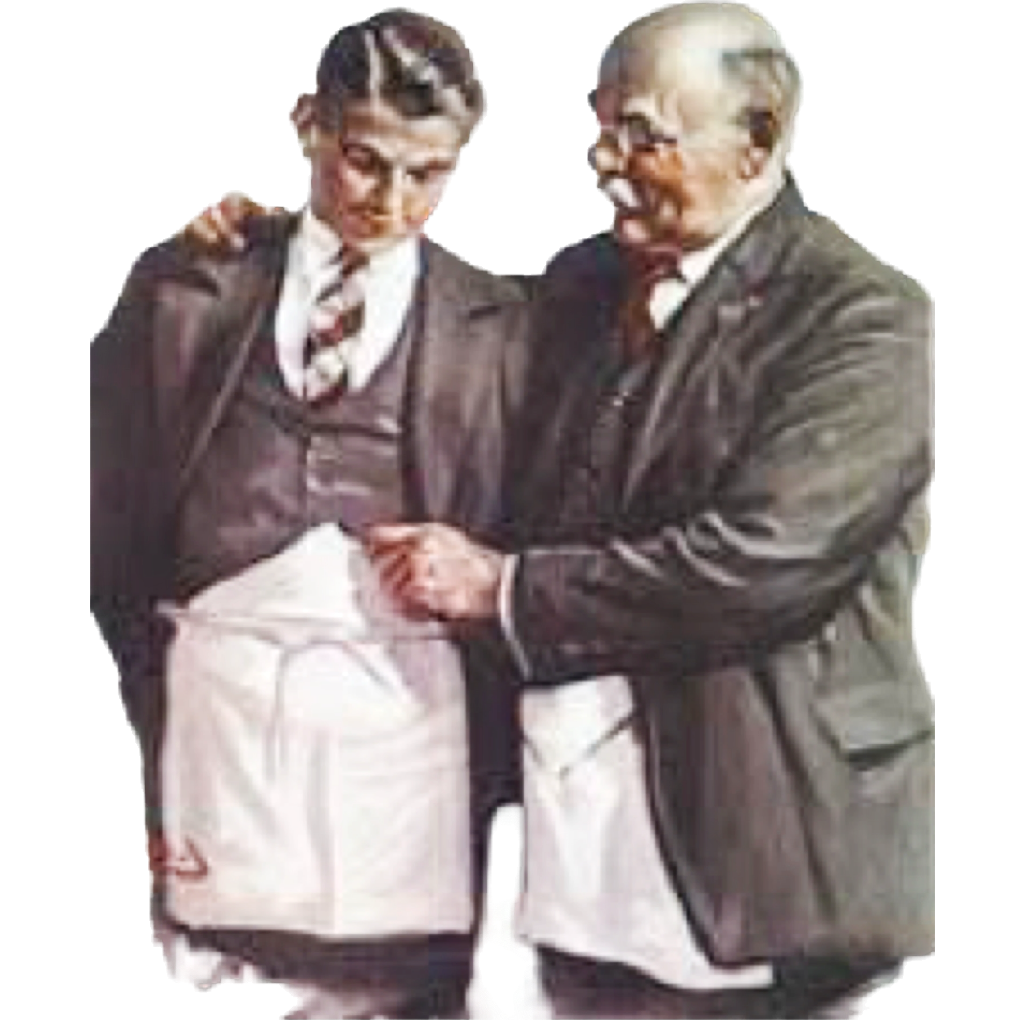
The Entered Apprentice’s apron showing the triangle facing up and the Fellowcraft‘s triangle down. Public Domain Image.
This custom is unfortunately going out of use in modern Masonry, which is a great pity, as undoubtedly a valuable lesson is thus lost.
The Fellowcraft has the flap pointing downward for several reasons;
Firstly, to indicate that wisdom has begun to enter and therefore to control matter;
secondly, to represent the triangle of water and thus indicate that Soul and Body are acting in unison;
thirdly, because this triangle is the emblem of Vishnu the Preserver, and so emphasises – the fact that the aspect of God taught in this degree is the preservative aspect, whereas the addition of the three rosettes in the third degree shows, not only the union of Body, Soul and Spirit, but also that the great lesson of this degree is the importance of the Destructive side of the Deity, or as we may prefer to tall it, the Transformative side.
What, however, of the two rosettes worn by the Fellowcraft ?
Firstly, they stress the dual nature of man, and have a very clear reference to the two pillars.
Similarly, no doubt, they indicate that the Fellowcraft is not yet a complete and united being; Body and Soul are in union, but unlike the Master Mason, these two are not in complete accord with the Spirit.
Thus we obtain a correspondence between the knocks of the Fellowcraft and the two rosettes.
Furthermore, the triangle is incomplete, showring that the Fellowcraft is not yet a complete Freemason and this correlates with the position of the compasses when taking the obligation in the Fellowcraft degree.
Two other features of the apron must also be considered. Firstly, the tassels, which appear originally to have been the ends of the string with which the apron was bound round the waist.
There is little doubt that in the 18th century the aprons had not the present symbolic tassels, but were fastened round the body in a very similar way to that in which the Entered Apprentice and Fellowcraft aprons are to this day.
It is interesting to note in this connection that the actual aprons worn by the officers of Grand Lodge for the year, as distinct from the Past Grand Officers’ aprons, have no tassels at all.
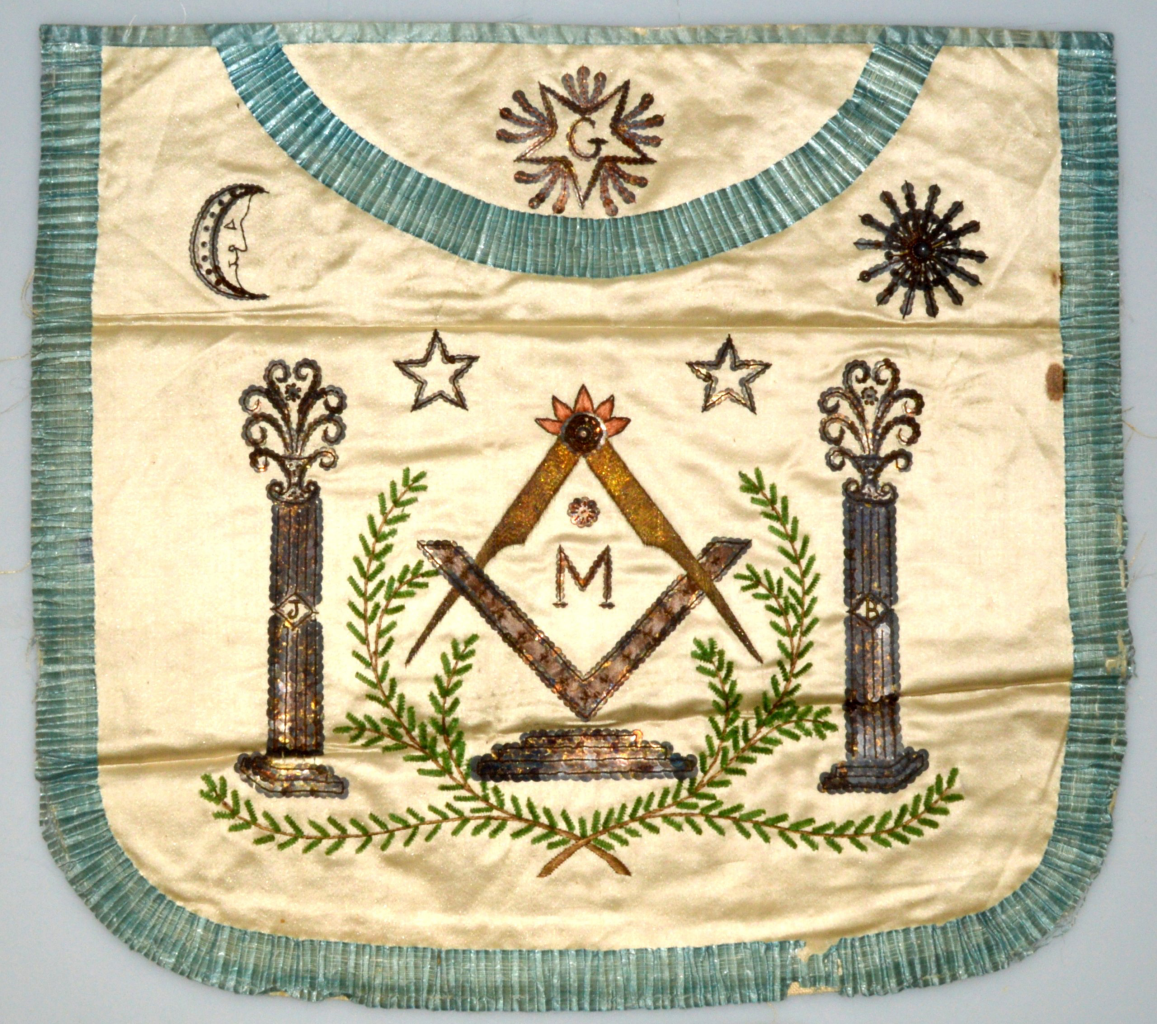
18th century Masonic Apron of Major William Christy – founder of North St. Louis and prominent member of St. Louis society. http://collections.mohistory.org/resource/216555
In the course of years, no doubt, the ends of the strings were ornamented by tassels, and to this day the aprons of the Royal Order of Scotland are bound round the body by an ornamental cord with tassels, which are tied in front in such a way that the two tassels stick out from underneath the flap.
These tassels, when the final form of our aprons was fixed, were separated from the bands which fasten the apron, and attached to the apron itself, becoming as we now see simply strips of ribbon on which are fastened seven chains.
When this change took place it is clear that those who made the alteration deliberately chose the number 7, and intended thereby to convey a symbolic meaning.
We have already explained the numerous symbolic meanings of the number 7; for example, it represents God and Man, Spirit and Matter, etc.
Naturally they had to have two tassels to balance, and it would have been very inartistic to have had four chains on one tassel and three on the other, and so it would be unwise to lay too much stress on the number 14, which is the sum total.
We may regard it merely as a curious and interesting coincidence that the body of Osiris was stated to have been divided by Set into 14 pieces.
But in addition to these details as to the historical development of the tassels, we must not forget that in many of the 18th century aprons the two pillars are depicted.
These aprons were usually decorated by paintings on the leather, and varied considerably from Lodge to Lodge, but one of the most usual kinds of decoration included the two pillars, and the remembrance of these may very probably have influenced those who designed our present apron.
The modern arrangement by which the apron is fastened, namely, a piece of webbing with a hook and eye attachment, gave a fine opportunity for some really profound symbolism, and I feel certain that it was not an accident which led to the universal adoption of the snake to serve this purpose.
There are two kinds of symbolism attached to the snake in all ancient religions.
Firstly, the snake as the enemy of man, and therefore as the representative of the powers of evil; and secondly the snake as emblem of the Divine Wisdom.
“Be ye wise as serpents”; does not refer to the craftiness of the Devil, but to the Divine Wisdom itself.
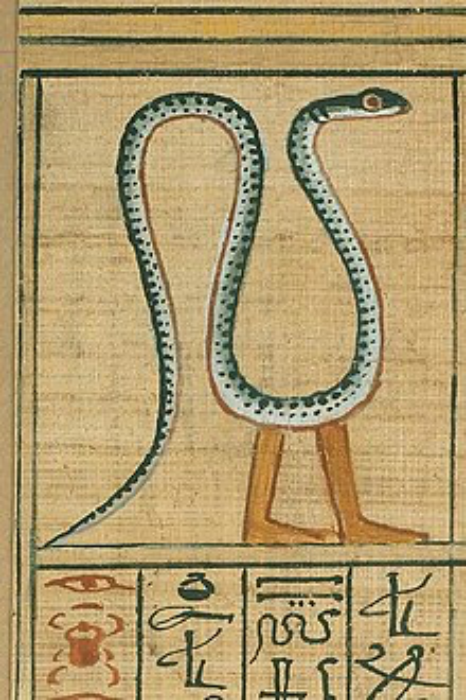
Nehebkau – the primordial snake god of the afterlife in ancient Egyptian mythology – depicted in Spell 87 of the Book of the Dead of Ani
IMAGE LINKED: wikimedia Attribution 4.0 International (CC BY 4.0)
In Ancient Egypt the Soul as he passed through the Underworld met with serpents of evil, and also with serpents of good.
In India, legend tells us of a whole order of beings, the Serpent Folk, who are of a Spiritual nature different from man, possessed their own rulers, and were endowed with superhuman wisdom.
Some of these are considered to be friendly to man, while others are hostile. The Sacred Cobra is well known to every student of Hindu religions, and is essentially good.
Actual worship is paid to the Serpent throughout the whole of India, and in many other parts of the world, and in the Kabala we get clear traces of the fact that under certain circumstances the serpent is regarded as “The Shining One” – the Holy Wisdom Itself.
Thus we see that the serpent on our apron denotes that we are encircled by the Holy Wisdom.
Finally, the serpent biting its tail [Ouroboros], and thus forming a circle, has always been regarded as the emblem of eternity, and more especially of the Eternal Wisdom of God. Nor must we forget that the snake is peculiarly associated with Shiva, whose close symbolic association with the third degree has already been clearly shown.
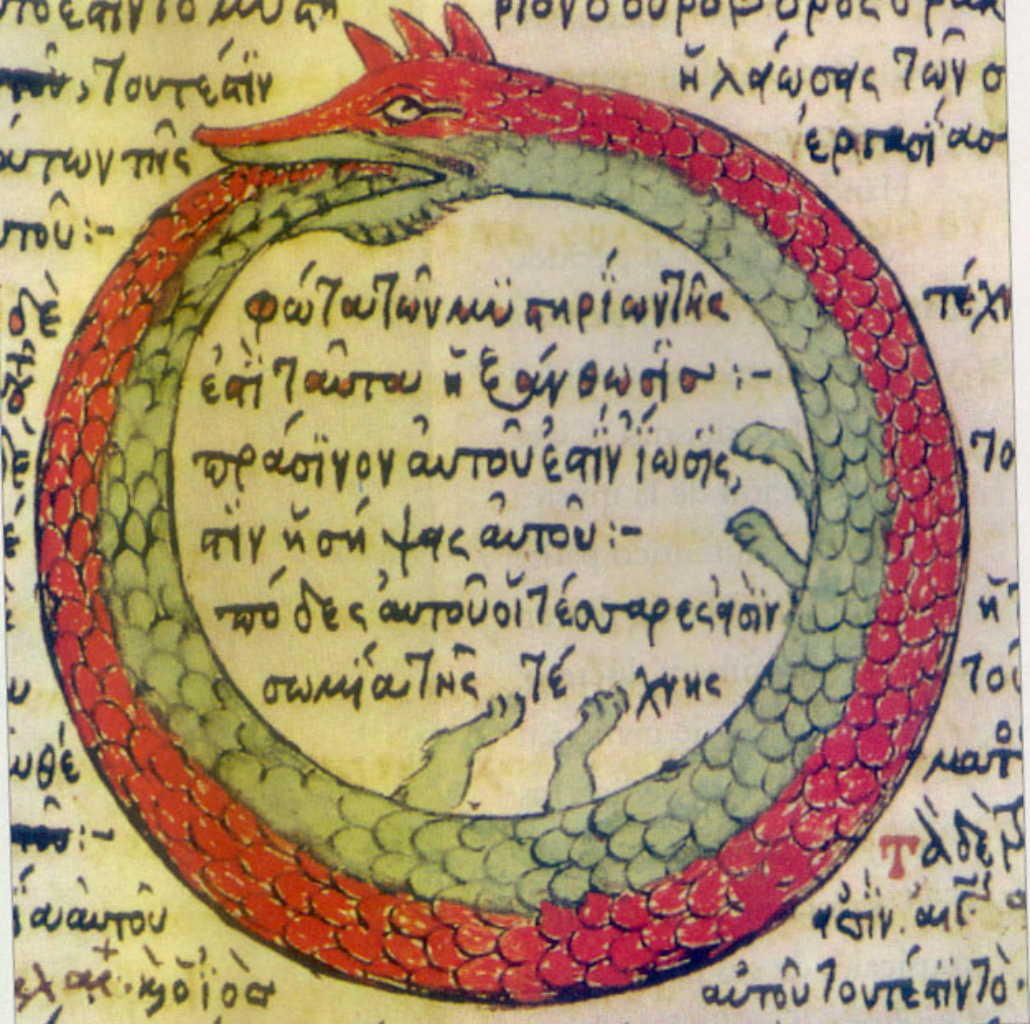
An ouroboros drawing from a late medieval Byzantine Greek alchemical manuscript (c.1478)
Much more might be written on the meaning of the apron, but we cannot devote any more space to this subject, interesting though it may be, although before considering our next point it will perhaps be well to recall what has already been mentioned in the Entered Apprentice Handbook, viz., that aprons, in addition to their Operative significance, have right through the ages been employed in connection with religious ceremonial.
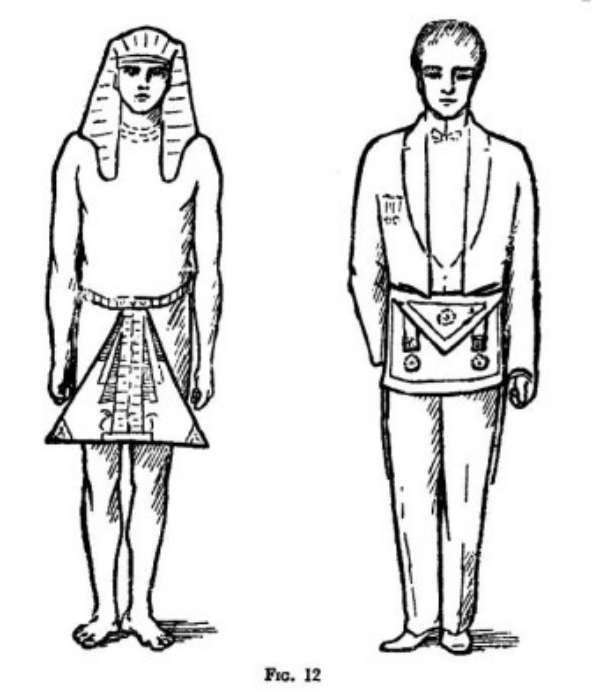
Image from “The Hidden Life in Freemasonry”, C. W. Leadbeater 33° (Theosophical Publishing House, India 1926)
On the monuments of Egypt a garment, which can best be described as a triangular apron with the point upward, is depicted in circumstances indicating that the wearer is taking part in some kind of ceremony of initiation.
In ancient Mexico the Gods are depicted wearing aprons, and it is not without interest to note that the modern Anglican bishop wears an apron, although it appears to have developed from a long flowing robe somewhat the shape of a cassock.
Article by: J. S. M. Ward
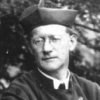
John Sebastian Marlow Ward (22 December 1885 – 1949) was an English author who published widely on the subject of Freemasonry and esotericism.
He was born in what is now Belize. In 1908 he graduated from the University of Cambridge with honours in history, following in the footsteps of his father, Herbert Ward who had also studied in history before entering the priesthood in the Anglican Church, as his father had done before him.
John Ward became a prolific and sometimes controversial writer on a wide variety of topics. He made contributions to the history of Freemasonry and other secret societies.
He was also a psychic medium or spiritualist, a prominent churchman and is still seen by some as a mystic and modern-day prophet.
Recent Articles: Master Mason's Handook J.S.M Ward

Book Review - The EA, FC, MM Handbooks
Essential reading for every Entered Apprentice, Fellowcraft, and Master Mason - these seminal books by J.S.M Ward are what every Mason needs!
more....
 The Master Mason's Handbook P1 Chapter 1 - Questions and Password; a brief explanation of the teaching of the third degree as contained in the symbols by J.S.M Ward |
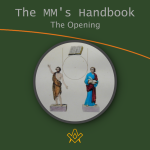 The Master Mason's Handbook P2 Chapter 2 - The Opening; a brief explanation of the teaching of the third degree as contained in the symbols by J.S.M Ward |
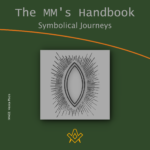 The Master Mason's Handbook P3 Chapter 3 - The Symbolical Journeys; We have seen in the previous books that the square and compasses are united on the pedestal in such a way as to form the Vesica Piscis, the emblem of the female principle, and the symbol of birth and rebirth. Hence symbolically the Candidate passes through the Vesica Piscis. |
 The Master Mason's Handbook P4 Chapter 4 - The Exhortation The opening part of the exhortation gives a convenient summary of the previous degrees and quite clearly indicates that the first inner meaning of the series is Birth, Life which is of course educational and preparatory for its sequel, and Death. |
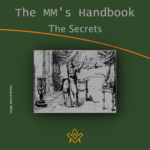 The Master Mason's Handbook P5 Chapter 5 - The Secrets. Having thus been brought into the place of light the Candidate is given not the genuine secrets, but only substituted ones. This fact must often have puzzled the Candidate. The practical reason given in the ritual, though perfectly intelligible to a Royal Arch mason (Companion) , cannot be the real one. |
 The Master Mason's Handbook P6 Chapter 6 - The Badge - On his re-entering the Lodge, the candidate is presented and in due course invested with the badge of a Master Mason by the S.W. The Badge itself, however, is full of symbolic meaning…. |
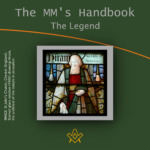 The Master Mason's Handbook P7 Chapter 7 - The Legend - After the ceremonial investiture of the Candidate the W.M. continues the narrative of the traditional history. At least this is the case in most English workings, but in some Scotch workings the whole story is told first, and subsequently the Candidate and the other brethren act the chief parts. Perhaps one of the most important points to realise is the correct meaning of the name Hiram Abiff . |
 The Master Mason's Handbook P8 Chapter 8 - The Tracing Board - The next part of the narrative is incorporated in most English workings with the Tracing Board. The most interesting feature is the description of the grave. It is obvious that peculiar stress is laid on the centre, even in the present form of our ritual, because of the way in which the measurements are given. |
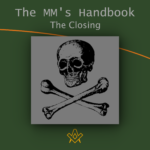 The Master Mason's Handbook P9/10 Chapters 9 & 10 The Closing Finally, even if a man can never fathom the full meaning of the third degree, yet there is no man worthy of the name who has passed through that third degree but will certainly have learnt one important lesson, namely, how to die, and thereby will be the better man. |
masonic knowledge
to be a better citizen of the world
share the square with two brothers

click image to open email app on mobile device



